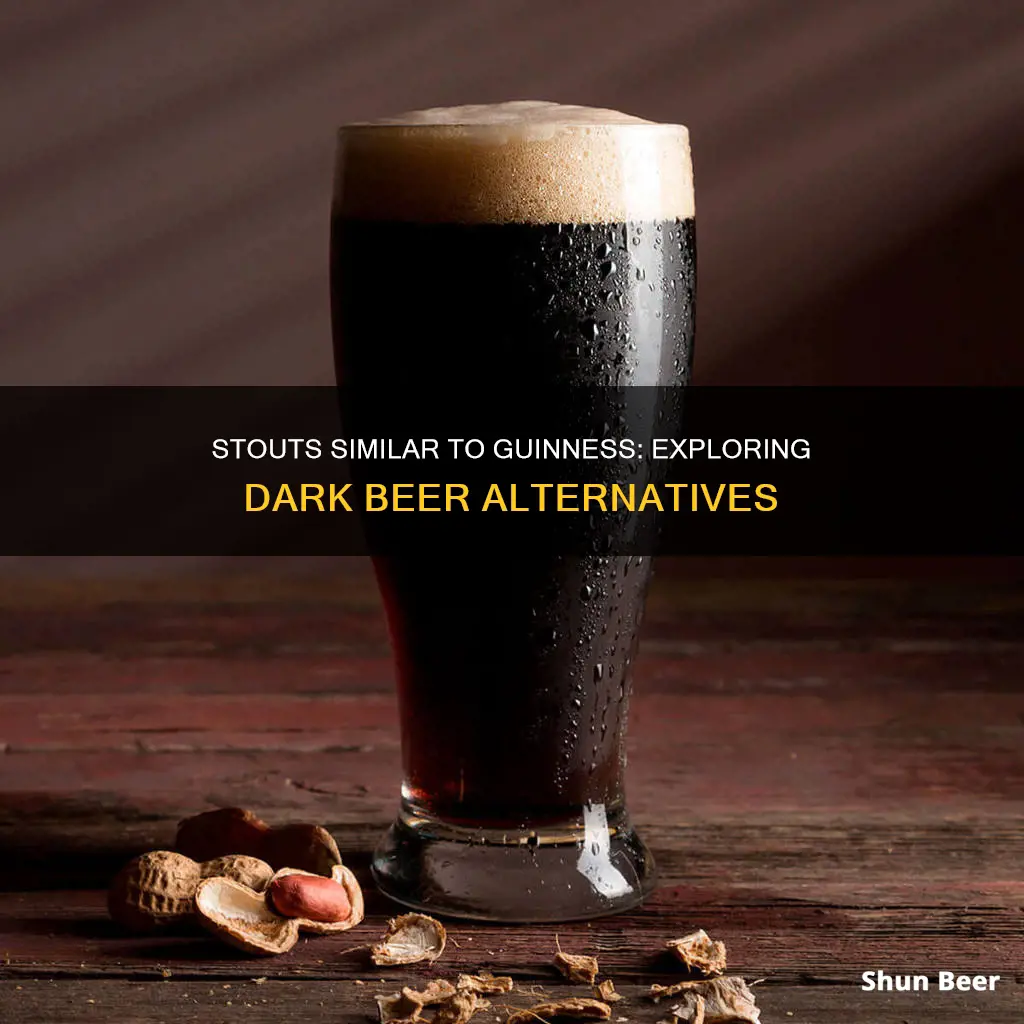
Guinness is a stout that originated in the brewery of Arthur Guinness at St. James's Gate, Dublin, Ireland, in the 18th century. It is now owned by the British-based multinational alcoholic beverage maker Diageo and is one of the most successful alcohol brands worldwide, brewed in almost 50 countries and available in over 120.
The distinctive flavour of Guinness derives from malted barley and roasted unmalted barley, with the latter being a relatively modern addition. The draught beer's thick, creamy head is achieved by mixing the beer with nitrogen and carbon dioxide.
Guinness has a range of beers, including stouts, lagers, and ales. The closest beer to the original Guinness stout is the Extra Stout, which has extra alcohol, extra roast, and extra bite. The Draught stout is a toned-down version, perfect for those new to Guinness.
In addition to its core range, Guinness has also released special editions and experimental beers, such as the West Indies Porter and the Baltimore Blonde.
| Characteristics | Values |
|---|---|
| Flavour | Malted barley and roasted unmalted barley |
| Texture | Creamy |
| Colour | Very dark shade of ruby |
| Taste | Sharp lactic acid |
| ABV | 4.1% to 8% |
| Brand Owner | Diageo |
What You'll Learn

Guinness Draught
The perfect pint of Guinness Draught is achieved through the beer's unique two-part pour. First, the glass is tilted at a 45-degree angle and filled three-quarters full. The beer is then allowed to settle before filling the glass completely, resulting in a beer that is savoured from the first sip to the last.
The nitrogen-infused bubbles in Guinness Draught are much smaller than those in carbonated beers, giving it a "creamier" and "smoother" consistency. This also means that Guinness Draught is less fizzy and easier to drink than other beers. It has a relatively low ABV of between 4.1 and 4.3%, although an Extra Cold version is served at 3.5 °C.
Guinness Beer: Does It Expire?
You may want to see also

Guinness Extra Stout
The Guinness Extra Stout is a direct descendant of the original Guinness recipe, first brewed in 1821 by Arthur Guinness II, who set down precise instructions for brewing his Superior Porter. It is the precursor to every Guinness innovation since.
The Extra Stout is a beloved icon in the West Indies, West Africa, and the Caribbean. It is subtly fruity with warming, roasted notes of coffee and dark chocolate. It has a robust flavour and a dry finish.
The Extra Stout is a dark ruby red with a frothy head. It is sharp and crisp to the taste with the trademark Guinness flavours at its core. It is heavier-bodied, maltier, and more carbonated than the Draught. It has a distinct bite and is distinctly more bitter, even sour.
The Extra Stout is best served ice-cold in a pint glass. It is a great "secret" ingredient in cooking, adding something extra to celebrations both big and small.
Guinness: A Dark Porter Beer With a Rich History
You may want to see also

Guinness Foreign Extra Stout
The recipe has evolved over the years, but its essence has remained the same. Foreign Extra Stout has a robust and roasted flavour with notes of dark chocolate, caramel, and dried fruits. It has a black liquid with a frothy head and a full-bodied coffee taste balanced with subtle sweetness.
The beer is known by different names in different parts of the world. In Malaysia, for example, it is known as the "Black Bulldog". The name originates from the early export bottlers of Guinness, who added their own symbols to distinguish their bottles and exclusive territories. The bulldog was one of the most famous symbols, along with the wolf, the dog, and a cat.
Guinness Beer: Healthy Brew or Just a Buzz?
You may want to see also

Guinness blends
Guinness is a stout that originated in the brewery of Arthur Guinness at St. James's Gate, Dublin, Ireland, in the 18th century. It is now owned by the British-based multinational alcoholic beverage maker Diageo. It is one of the most successful alcohol brands worldwide, brewed in almost 50 countries, and available in over 120.
The distinctive flavour of Guinness derives from malted barley and roasted unmalted barley. The draught beer's thick, creamy head is achieved by mixing the beer with nitrogen and carbon dioxide.
Guinness has a long history of innovation and experimentation, constantly creating new recipes and beer styles. The brand has also expanded its range to include alcohol-free and low-alcohol options.
Black and Tan
This blend is created by pouring a British ale, such as Bass Ale, and Guinness. The Bass Ale provides a fruity, herbal element, with a brighter crispiness that complements the roastiness of Guinness.
Blacksmith
A blend of Guinness and Smithwick's Premium Irish Ale. Smithwick's adds fruity elements, caramel, and toffee character to the blend, resulting in a slightly sweeter finish.
Black Lady/Dirty Blonde/Black & Blonde
A combination of Guinness and Stella Artois. The skunky elements of Stella Artois are likely to be subdued in this blend, resulting in a lighter, crisper palate.
Black & Blue
A blend of Guinness and Blue Moon, a Belgian witbier-style beer. The orange and spice notes in Blue Moon are expected to create interesting interactions with the coffee and roasty flavours of Guinness.
Chocolate Covered Cherry/Black & Cherry
This blend combines Guinness with Sam Adams Cherry Wheat. The cherry flavour is expected to be prominent, with a creamy mouthfeel and a medium body.
Black & Tan Smooth/Black Velvet
A blend of Guinness and Kilkenny Cream Ale, another beer brewed by Guinness. Kilkenny adds caramel and sourdough flavours, resulting in a smooth, dry finish.
Poor Man's Black Velvet
A blend of Guinness and Magners Irish Cider (or other cider brands). The cider adds sweet-tartness and aromas of green apple to the blend, with a slightly sweeter finish.
Black Honey/Bumble Bee
A combination of Guinness and Honey Brown Lager. The honey sweetness of the lager is expected to complement the roastiness of Guinness, with added zippiness from the lager's carbonation.
Midnight in the Garden
A blend of Guinness and Hoegaarden White, a Belgian witbier. This blend is expected to be bright and spicy, with hints of citrus, banana, and other spices from the Belgian yeast. The carbonation and spice add a spritely palate while retaining some creaminess.
Black Castle
A combination of Guinness and Newcastle Brown Ale. The added carbonation from the brown ale makes the blend less smooth, with more hop presence and a dry finish.
Half and Half
A blend of Guinness and Harp Lager, another beer brewed by Guinness. Harp Lager adds sweetness and graininess to the blend, with a zipper mouthfeel due to its higher carbonation.
These blends are just a few examples of the endless possibilities of Guinness combinations. Whether you're a seasoned Guinness drinker or new to the world of stouts, experimenting with different blends can be a fun way to explore and discover new flavours.
Guinness Beer: Wheat-Free, But What's the Secret?
You may want to see also

Guinness alcohol-free
Guinness is a stout that originated in the brewery of Arthur Guinness at St. James's Gate, Dublin, Ireland, in the 18th century. It is now owned by the British-based multinational alcoholic beverage maker Diageo. It is one of the most successful alcohol brands worldwide, brewed in almost 50 countries, and available in over 120.
In 2020, Guinness announced the introduction of a zero-alcohol canned stout, Guinness 0.0. It was withdrawn from sale almost immediately after launch due to contamination but was relaunched in 2021, first in pubs and then in cans. Guinness 0.0 is brewed in the same way as regular Guinness, using the same natural ingredients: water, barley, hops, and yeast. The alcohol is then gently removed through a cold filtration method, which protects the integrity of its taste and character. The brewers then carefully blend and balance the flavours to ensure the distinctive flavour profile and taste characteristics of Guinness. The resulting product is a non-alcoholic stout that is unmistakably Guinness, with a dark ruby red colour, a creamy head, and hints of chocolate and coffee, smoothly balanced with bitter, sweet and roasted notes.
Guinness 0.0 has been described as slightly thinner and sweeter than regular Guinness, though this is only really perceptible when the two are drunk side by side. It has a similar "creamier" and "smoother" consistency to regular Guinness due to the use of nitrogen, which creates smaller bubbles than carbon dioxide.
Guinness 0.0 was the UK's best-selling non-alcoholic beer in shops in 2024, and non-alcoholic Guinness now accounts for 3% of all Guinness sales worldwide. Sales doubled over the year to June 2024 amid an increase in sobriety and moderation among the public, particularly young people. Anna MacDonald, Guinness marketing director at Diageo, has predicted that Guinness 0.0 could one day overtake sales of regular Guinness, as the alcohol-free trend is "accelerating more than we [Diageo] thought".
Guinness 0.0 is not the first non-alcoholic beer produced by Guinness. In 2010, Guinness launched Guinness Mid-Strength, a low-alcohol stout test-marketed in Limerick, Ireland, and Dublin, with 2.8% ABV. In 2014, they released Guinness Blonde, a lager brewed in Latrobe, Pennsylvania, using a combination of Guinness yeast and American ingredients. In 2015, they released Hop House 13, a lager that was withdrawn from sale in the UK in 2021 due to poor sales but remains on sale in Ireland.
Guinness Beer: Artificial Coloring or Natural Magic?
You may want to see also
Frequently asked questions
If you're looking for an alternative to Guinness, you could try a Bass Ale. It's a full-flavored ale with a slightly burnt roast aroma and a high-quality, full-bodied flavor.
Guinness is a dry Irish stout, which is not a heavy beer. If you're looking for something lighter, you might want to try a lager or an American IPA.
If you're looking for a less strong alternative to Guinness, you could try a Harp Lager. It's a crisp and clean lager with a slightly bitter taste and a smooth aftertaste.
If you're looking for a sweeter alternative to Guinness, you could try a Magners Irish Cider. It's made with 17 varieties of apples and has a sweet and tart taste.







